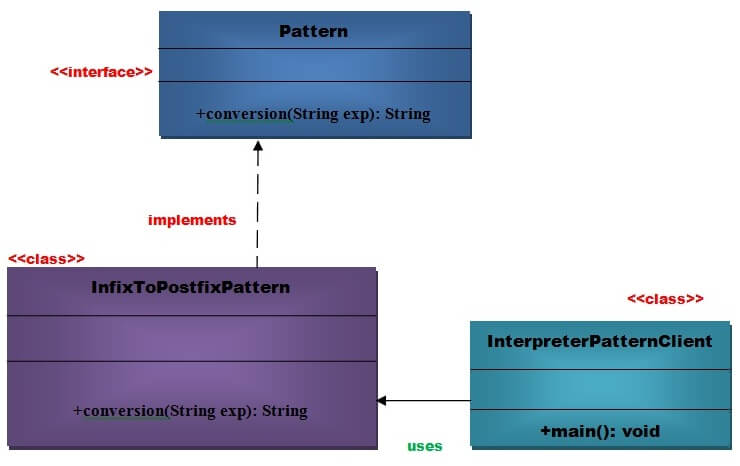Interpreter Pattern
Interpreter Pattern
An Interpreter Pattern says that “to define a representation of grammar of a given language, along with an interpreter that uses this representation to interpret sentences in the language”.
Basically the Interpreter pattern has limited area where it can be applied. We can discuss the Interpreter pattern only in terms of formal grammars but in this area there are better solutions that is why it is not frequently used.
This pattern can applied for parsing the expressions defined in simple grammars and sometimes in simple rule engines.
Advantage of Interpreter Pattern
- It is easier to change and extend the grammar.
- Implementing the grammar is straightforward.
Usage of Interpreter pattern:
It is used:
- When the grammar of the language is not complicated.
- When the efficiency is not a priority.
Example of Interpreter Pattern
Let’s understand the example of Interpreter Pattern by the above UML diagram.
UML for Interpreter Pattern:

Implementation of above UML
Step 1
Create a Pattern interface.
public interface Pattern {
public String conversion(String exp);
}
Step 2
Create a InfixToPostfixPattern class that will allow what kind of pattern you want to convert.
import java.util.Stack;
public class InfixToPostfixPattern implements Pattern {
@Override
public String conversion(String exp) {
int priority = 0;// for the priority of operators.
String postfix = “”;
Stack<Character> s1 = new Stack<Character>();
for (int i = 0; i < exp.length(); i++)
{
char ch = exp.charAt(i);
if (ch == ‘+’ || ch == ‘-‘ || ch == ‘*’ || ch == ‘/’||ch==‘%’)
{
// check the precedence
if (s1.size() <= 0)
s1.push(ch);
}
else
{
Character chTop = (Character) s1.peek();
if (chTop == ‘*’ || chTop == ‘/’)
priority = 1;
else
priority = 0;
if (priority == 1)
{
if (ch == ‘*’ || ch == ‘/’||ch==‘%’)
{
postfix += s1.pop();
i–;
}
else
{ // Same
postfix += s1.pop();
i–;
}
}
else
{
if (ch == ‘+’ || ch == ‘-‘)
{
postfix += s1.pop();
s1.push(ch);
}
else
s1.push(ch);
}
}
}
else
{
postfix += ch;
}
}
int len = s1.size();for(
int j = 0;j<len;j++)postfix+=s1.pop();return postfix;
}}// End of the InfixToPostfixPattern class.
Step 3
Create a InterpreterPatternClient class that will use InfixToPostfix Conversion.
public class InterpreterPatternClient {
public static void main(String[] args) {
String infix = “a+b*c”;
InfixToPostfixPattern ip = new InfixToPostfixPattern();
String postfix = ip.conversion(infix);
System.out.println(“Infix: ” + infix);
System.out.println(“Postfix: ” + postfix);
}
}
Output:
Infix: a+b*c
Postfix: abc*+